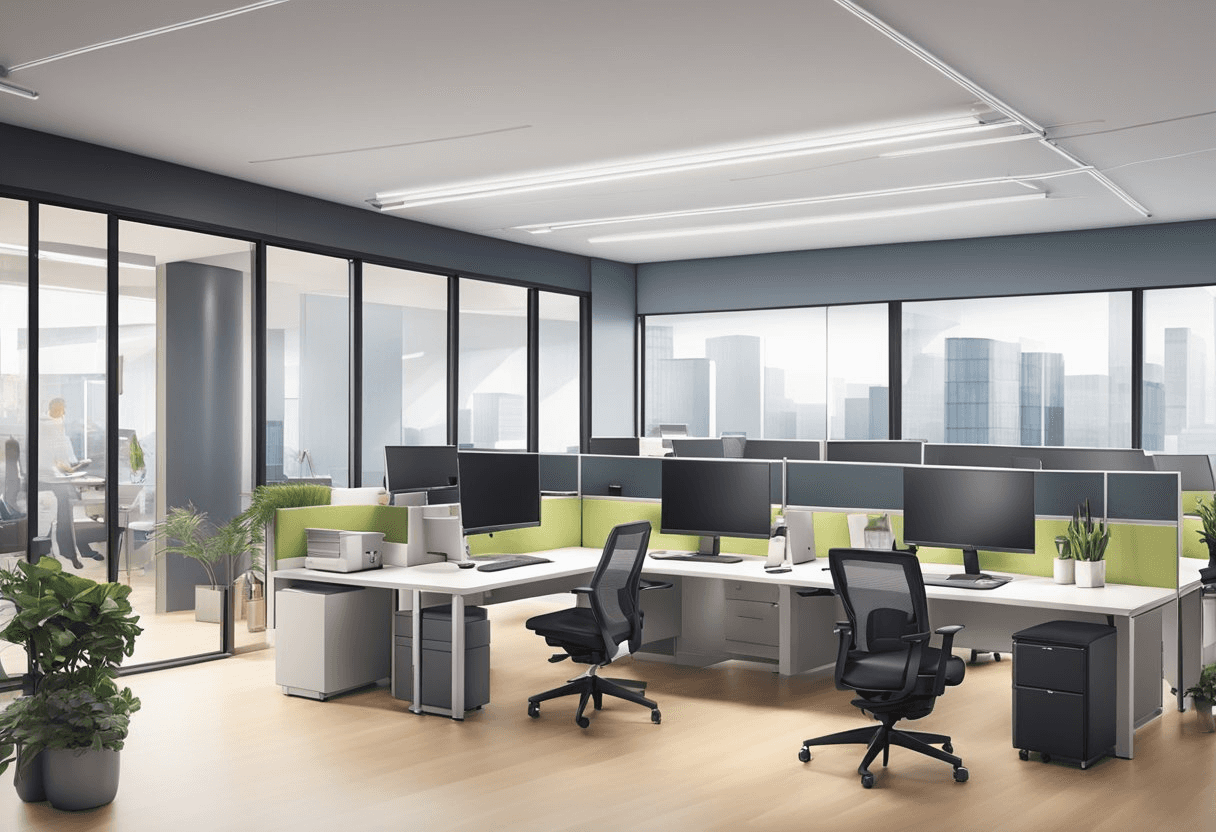Glossary: HR & Recruiting Definitions
The landscape of employment is rapidly transforming, and flexibility has become a central pillar of this new world. The future of work is shaping up to be an amalgamation of remote, onsite, and hybrid models, creating a workforce that is both dynamic and adaptable. Businesses are now faced with the challenge of navigating these changes while maximizing productivity and employee satisfaction. Strategies are being developed to manage distributed teams, ensure seamless communication, and foster a culture that supports these varied working environments.

In particular, hybrid work, which combines remote and in-office arrangements, is predicted to emerge as a prevalent structure. This model offers employees the autonomy to work from locations where they feel most productive, while still maintaining the option of a physical space for collaboration and social interaction. As organizations gear up for the workforce of the future, they are reevaluating traditional office designs and technology infrastructures to support a blend of synchronous and asynchronous work.
Integral to this shift is the recognition that a one-size-fits-all approach is obsolete. Instead, the focus now lies in crafting policies and programs that are tailored to the individual needs of employees, ensuring they have the tools and flexibility necessary to thrive. By leveraging insights from industry experts and research, successful organizations are crafting a future of work that is not only resilient but also responsive to the continual evolution of the global marketplace.
Building a Flexible Work Culture

In an era where adaptability reigns, organizations are tasked with creating a flexible work culture that aligns with both business objectives and employee needs. Embracing flexibility involves adopting strategies that not only support varied work schedules but also cultivate trust, inclusivity, and innovation.
Implementing Hybrid Work Models
Hybrid work models allow employees to split time between the office and remote locations, offering a blend of structure and freedom. The performance of these models is often grounded in clear communication and set expectations regarding availability and deliverables.
Fostering Trust and Well-Being
Building a culture that prioritizes employee well-being fosters trust and work-life boundaries, effectively reducing burnout. Trust is a two-way street; employers provide autonomy, and employees commit to maintaining productivity and performance.
Leadership in Dynamic Environments
Leaders must adapt their strategies to guide a flexible workforce. By demonstrating a commitment to flexible working, they set the tone for a dynamic, resilient culture, where communication and regular check-ins keep teams aligned and engaged.
Embracing Diversity and Inclusion
A flexible culture welcomes different perspectives and supports a diverse talent pool. Organizations must commit to inclusive policies that not only accommodate but celebrate varied needs and identities within the workforce.
Optimizing Office and Remote Setups
Adapting physical spaces to be more efficient and investing in technology infrastructure are key to a successful flexible work culture. Office layouts should foster collaboration, while remote setups need to be as efficient and engaging as their in-office counterparts.
Leveraging Talent and Skills
Flexible environments enable firms to access broader talent pools, as geographical constraints diminish. However, managing flexible teams requires a sharp focus on nurturing skills and aligning talent with the tasks where they can excel.
Developing Resilient Policies and Practices
The shift to a flexible work model necessitates the development of resilient policies that reflect the evolving landscape, such as the aftermath of the COVID-19 pandemic. Policies should establish clear work-life boundaries while being adaptable to future disruptions.
Enabling Continuous Learning and Innovation
Continuous learning is the backbone of a future-proof company. Organizations must embrace programs that encourage the acquisition of new skills and drive innovation to remain competitive in an ever-changing market.
Adapting to Evolving Employee Expectations
Recognizing and meeting evolving employee expectations are critical to maintaining a vibrant company culture. Millennials and subsequent generations anticipate employers to offer not just a job but a career that supports their individual lifestyle and values.
Designing the Workspace of Tomorrow

The future workspace is being sculpted by groundbreaking approaches in office design and technology, aimed at enhancing flexibility and efficiency.
Redefining the Physical Workspace
Flexible working has become a cornerstone for technology companies, prompting a shift in office design. These changes manifest in physical layouts that prioritize modular environments and communal spaces. The methodology behind this evolution focuses on layouts that transition seamlessly between individual tasks and collaborative projects. For instance, WeWork’s design report has observed a marked increase in open floor plans, indicating that the traditional office design with its fixed footprint is giving way to more dynamic and adaptive spaces. The goal is to create physical spaces that are not just places of work, but hubs of creativity and innovation.
Furthermore, the integration of nature through biophilic design has been another key feature in reimagining office environments. Aspects like natural light, plants, and materials that evoke nature contribute to a space where employees can feel more relaxed and productive.
Expanding Beyond Geographical Boundaries
The hybrid model transcends beyond physical space, reducing reliance on a central location. This fluid approach expands talent pools to a global scale, allowing companies to harness expertise from a diverse range of regions and cultures. The methodology here incorporates a blend of in-person and virtual interfaces, emphasizing a digital infrastructure that supports real-time collaboration from any place.
Real-estate strategies are also adapting, with some companies choosing to reduce their physical offices' footprint in favor of shared spaces or satellite hubs. These flexible working arrangements offer employees the autonomy to choose their ideal work setting, whether it be from home, a local coworking space, or the headquarters. This methodology not only reduces overhead costs but also can lead to heightened employee satisfaction and retention.
By tailoring both the physical and virtual work environments, companies can sustain a productive and enthusiastic workforce prepared to meet the volatile demands of a rapidly changing market.
Frequently Asked Questions

Dynamic work environments are increasingly prevalent, responding to the need for improved work-life balance and adaptation to rapid changes in the business landscape. These environments are characterized by their flexible work arrangements, which bring distinct advantages and challenges that organizations and their workforces must navigate.
What are the key benefits of implementing flexible work arrangements?
Flexible work arrangements offer several benefits including increased employee satisfaction, higher retention rates, and the ability to attract a diverse workforce. By enabling a better balance between professional and personal life, companies often see a boost in overall morale and productivity.
How do flexible work environments adapt to changing market dynamics?
Flexible work environments leverage technology and a culture of adaptability to quickly respond to market changes. They can adjust their workforce distribution, work hours, and project management approaches to meet fluctuating demands, making dynamic adaptation an inherent feature.
What challenges do companies face when introducing flexible working hours?
One challenge is ensuring communication and collaboration across different schedules and locations. There's also the risk of some employees feeling isolated or disengaged from the team. Establishing clear guidelines and leveraging communication tools are fundamental in mitigating these issues.
What are some successful examples of companies with dynamic work environments?
Companies like Okta have been recognized for their dynamic work environments, where they've shifted to hybrid and remote models, keeping in step with the future of work trends for 2024 and beyond.
How can organizations ensure productivity with flexible work arrangements?
Organizations can maintain productivity by setting clear expectations, using result-oriented performance metrics, and providing the necessary tools for remote collaboration. These strategies help align individual goals with the company's objectives, regardless of the physical workplace setup.
What strategies can businesses employ to overcome the disadvantages of flexible working?
Businesses can implement structured policies to create a foundation for success in flexible environments. This includes establishing core hours for availability, promoting a results-focused culture, and providing support systems for remote communication. Overcoming these disadvantages often revolves around strategies to build trust and clarity amongst distributed teams.
Elevate hiring for you and candidates
Starting your recruitment journey? Cooper ensures that your job listings reach candidates across all relevant channels
Already have an account?
Discover the strategic integration and management of freelancers in HR with this detailed guide. Learn about the benefits and challenges of the freelance workforce, and explore effective practices for maximizing their contribution to organizational success.
FTE is a unit that indicates the workload of an employed person in a way that makes workloads comparable across various contexts. It is an essential metric used by HR professionals to calculate the number of part-time or contractual workers who can be substituted for a full-time employee. Understanding FTE helps in effective staffing and budgeting in organizations.
The Future of Work encompasses the changing dynamics in the workplace, driven by automation, digitization, artificial intelligence (AI), and remote working models. It's about how these elements are reshaping the nature of jobs, the structure of organizations, and the strategies for managing and developing talent.
